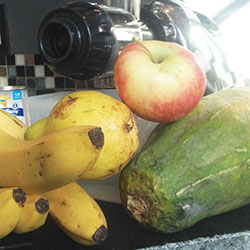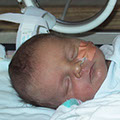 About Margot
About Margot
Born in 2000, Margot went straight into the NICU for a month
 GoPro Hero
GoPro Hero
Everyday, incredible
accomplishments captured on video
 Smile!
Smile!
3 providers, 4 months, 5 appointments, too many phone calls, to fix 1 cavity
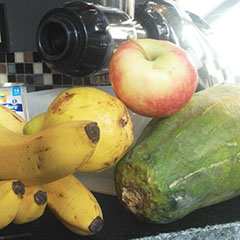 Real food, real meals
Real food, real meals
From drip-feeding a chemical blend to real food. Recipes included!
 No "Can't Do"
No "Can't Do"
A new video challenging assumptions about what Margot can enjoy and do.
 Siege or surrender
Siege or surrender
On a Christmas trip to the tropics, I waved a white flag to our new reality.
 Prisoner of Routine
Prisoner of Routine
Creating functional & fun routines took lots of effort but salvaged our sanity.
 Trail Adventures
Trail Adventures
A blog for the Rails to Trails Conservancy offers tips to help hit the trails.
 Leap of faith: Act I
Leap of faith: Act I
My hopes took a hit, so I needed inspiration to take risks again, like kayaking.
 Leap of faith: Act II
Leap of faith: Act II
Inspired to kayak? From idea to implementation, and a lesson for research.
 It's all downhill!
It's all downhill!
Can Margot learn to ski? With expert help and sensible teaching, yes!
 Best summer ever!
Best summer ever!
After 18 years, getting summer right for Margot and the whole family!
Adventures with Margot: Supplemental Materials
The Right Stuff for Margot: Recipes to help her to gain healthy weight
November 30, 2016; Updated December 30, 2016 and January 10, 2019
My disclaimer
I am sharing this page and the linked recipes so that you can see the choices I made and strategies I used to try to create a healthy diet for Margot. But this page does not constitute or substitute for professional advice: you should consult with your doctor before trying anything similar.
How I started
I began with a simple meal of cooked oatmeal. I blended it with Pediasure so that it would be thin enough to pass through her tube. And that became her daily breakfast!
I began to look for other foods that were blended. Of course, baby food with no chunks was a possibility, but these come in small quantities. Blended yogurt seemed like a great option, especially for the probiotics. And there are some blended soups offered by Trader Joe's and other brands that can be used as is (like the Butternut Squash soup to the right), although these fall short of the calories in a comparable quantity of Pediasure.
Which foods?
I break possible foods into different categories of recipes: fruits, vegetables, greens, grains, beans, and meat. One of these foods serves as a base for each recipe, constituting 30-50% of the total volume.
Other foods supplement these by easily adding calories (like oil or half & half), protein (like nuts), or fiber (like oat, wheat, or rice bran).
Foods that can be bought in large quantities and easily prepared are really helpful. Even better are foods that are already pureed or easily pureed (like soups, sauces, and yogurts).
While transitioning to an all natural diet, I continued to use Pediasure as the base. For most recipes, I used about 4 cans/4 cups for every 4-6 cups of natural foods. It helped to thin the kinds of foods listed above to the right consistency to go through the tube, while keeping the calories high.
We are now transitioning Margot completely off of Pediasure, after alot of planning. Our planning had several goals in mind
- Some of the planning was needed to yiled some planning. If I replace Pediasure with milk or soy milk, I will lose calories. So I will either have to supplement these recipes with more calorie-rich liquids (like oils or cream), or plan on increasing the total volume of her feeds.
My favorite foods
 These meet the criteria outlined above.
These meet the criteria outlined above.
- Fruits: Bananas, Papayas, Apples (including applesauce)
- Vegetables: Carrot (steamed or soup), Squash (steamed or soup), mushrooms (lightly cooked), baby kale or frozen spinach (lightly cooked)
- Beans: Tofu, edamame
- Grains: Oatmeal, Oat / Rice/ Wheat Bran (as a supplement)
- Meats: Chicken, hamburger, salmon (all cubed, simmered slowly in milk until soft, and then ground); Eggs (scrambled)
- Nuts: Peanut (ground, dry-roasted, unsalted - or peanut butter)
- Dairy: Greek yogurt, half and half
- Oils: Flaxseed, olive
How much?
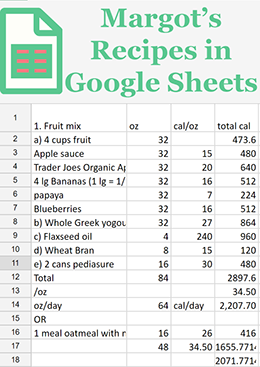 I began by confirming Margot's daily needs with her dietitian - she needed a total of 2000 calories and 80 oz of liquids each day. We had already established a pattern of 4 16 oz/feeds each day. That meant that I needed only to supplement with an additional 16 oz/day of water and Margot would get her liquids in.
I began by confirming Margot's daily needs with her dietitian - she needed a total of 2000 calories and 80 oz of liquids each day. We had already established a pattern of 4 16 oz/feeds each day. That meant that I needed only to supplement with an additional 16 oz/day of water and Margot would get her liquids in.
The first real food I tried with Margot (to introduce fiber into her diet) was 1 cup of cooked oatmeal thinned with 8oz of pediasure. It was easy to prepare and successfully relieved Margot's constipation, so this has become her breakfast every day. So that meant an additional 48oz/day of other mixes.
I then created 5 different kinds of recipes: fruit, vegetable, green, meat, and bean-based. Each recipe included some kind of liquid (pediasure, milk, soy milk) . Most recipes included some bran. And some recipes were boosted with high calorie items (oils, nuts, cream). I created a google sheet with different calorie calculations for each kind of food, calculated per oz. Calorie counts were take from packaging, or from taken from calorieking. I juggled the specific liquids and calorie supplements to bring the calorie/oz to around 30. The result is that, assuming 1 meal/day of oatmeal, Margot's intake varied between 1900 and 2100 calories/day.
How to prepare foods?
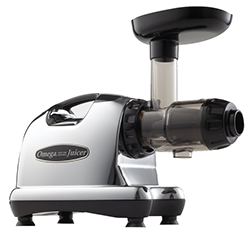 Creating recipes thin enough to pass through a g-tube is a big challenge. One solution is the use of a food grinder. I opted for an Omega masticating juicer (about $260 from Amazon). I wanted something powerful enough to grind meat and nuts. I would love to hear if anyone is able to get this covered as essential medical equipment! Sometimes I put food through a 2nd time, just to be sure there are no chunks big enough to clog her extension tube - that is a real pain!
Creating recipes thin enough to pass through a g-tube is a big challenge. One solution is the use of a food grinder. I opted for an Omega masticating juicer (about $260 from Amazon). I wanted something powerful enough to grind meat and nuts. I would love to hear if anyone is able to get this covered as essential medical equipment! Sometimes I put food through a 2nd time, just to be sure there are no chunks big enough to clog her extension tube - that is a real pain!
A powerful food processor is essential. Even ground food has to be thoroughly mixed to not clog her tubes. After I have added the final ingredients, I let the food processor run for at least a minute. But there are two times when a hand held mixer is adequate. First, when I mix her cooked oatmeal with 8o of whole milk or Pediasure in the morning. And second, when a recipe risks overflowing my food processor. In this case, I mix as much of the heavier foods as I can in the food processor, transfer the mix to a large bowl, add the final 8 - 16oz of milk or pediasure, and finish it off with the handheld blender.
I use 1/2 and 1 quart mason jars to store her processed food. Right now, Margot takes 1/2 quart per feed, so that makes it easier to send the right quantities into school. And mason jars are cheap, easy to clean, and do not leach chemicals into food (unlike some plastics). I can also freeze Margot's food in the jars - handy when we are going someplace when preparing food will be difficult (make sure you leave enough headroom or your jars will break!).
 I have also begun to buy some food in bulk, and then grind it and freeze it. Since my fruit and veggie recipes always call for a quart, I simply grind enough food to fill a quart jar, dump it into a quart Ziploc bag, and then freeze it. Tw0 hours or so before I am ready to mix up a batch, I just immerse the ziploc in a pot of water and it quickly thaws. I have primarily used this strategy when I harvest butternut squash or pumpkin from my garden at the end of the season, or when I buy a bushel of apples from our local orchard.
I have also begun to buy some food in bulk, and then grind it and freeze it. Since my fruit and veggie recipes always call for a quart, I simply grind enough food to fill a quart jar, dump it into a quart Ziploc bag, and then freeze it. Tw0 hours or so before I am ready to mix up a batch, I just immerse the ziploc in a pot of water and it quickly thaws. I have primarily used this strategy when I harvest butternut squash or pumpkin from my garden at the end of the season, or when I buy a bushel of apples from our local orchard.
Finally, a pressure cooker is handy for quickly cooking some beans and vegetables in quantity.
Other strategies?
Balancing her diet
 At the beginning, I sought to balance foods each day, and ended up with four different kinds of food at a time in my fridge (e.g., a fruit recipe, veggie recipe, bean recipe, and green recipe). But for reasons which I have never quite worked out, some of these recipes spoil quickly. So instead, I simply rotate recipes. The total number of calories per day is balanced, and she is getting milk and grains each day. While she is not getting a balance of fruits, veggies, meats, greens, and beans each day, she is getting a balance over the course of 8-10 days.
At the beginning, I sought to balance foods each day, and ended up with four different kinds of food at a time in my fridge (e.g., a fruit recipe, veggie recipe, bean recipe, and green recipe). But for reasons which I have never quite worked out, some of these recipes spoil quickly. So instead, I simply rotate recipes. The total number of calories per day is balanced, and she is getting milk and grains each day. While she is not getting a balance of fruits, veggies, meats, greens, and beans each day, she is getting a balance over the course of 8-10 days.
 I have recently begun getting more organized, and now put her recipes in 1/2 quart jars, and freeze and label them as is the picture. Now I can simply select different jars each day, as long as they add up to 2000 calories.
I have recently begun getting more organized, and now put her recipes in 1/2 quart jars, and freeze and label them as is the picture. Now I can simply select different jars each day, as long as they add up to 2000 calories.
Don't clog the tube!
It doesn't take much to clog a g-tube, so I have worked out a couple of strategies. Some recipes call for cooking to soften the food before grinding, and result in fewer and softer chunks. Carefully peeling some fruits and vegetables is key! And some foods will just never grind well.
 About Margot
About Margot
Born in 2000, Margot went straight into the NICU for a month
 GoPro Hero
GoPro Hero
Everyday, incredible
accomplishments captured on video
 Smile!
Smile!
3 providers, 4 months, 5 appointments, too many phone calls, to fix 1 cavity
 Real food, real meals
Real food, real meals
From drip-feeding a chemical blend to real food. Recipes included!
 No "Can't Do"
No "Can't Do"
A new video challenging assumptions about what Margot can enjoy and do.
 Siege or surrender
Siege or surrender
On a Christmas trip to the tropics, I waved a white flag to our new reality.
 Prisoner of Routine
Prisoner of Routine
Creating functional & fun routines took lots of effort but salvaged our sanity.
 Trail Adventures
Trail Adventures
A blog for the Rails to Trails Conservancy offers tips to help hit the trails.
 Leap of faith: Act I
Leap of faith: Act I
My hopes took a hit, so I needed inspiration to take risks again, like kayaking.
 Leap of faith: Act II
Leap of faith: Act II
Inspired to kayak? From idea to implementation, and a lesson for research.
 It's all downhill!
It's all downhill!
Can Margot learn to ski? With expert help and sensible teaching, yes!
 Best summer ever!
Best summer ever!
After 18 years, getting summer right for Margot and the whole family!
